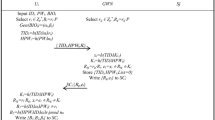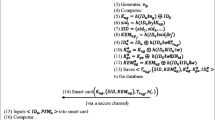Abstract
Secure information exchange in wireless sensor networks (WSN) is a continuing issue since the resource-constrained sensors generally deployed over an unattended environment. To access the real-time data from the sensors, user authentication and key agreement as an important tool for secure communications in WSN plays a vital role. Recently, Das proposed an efficient biometrics based security scheme by only using lightweight symmetric-key primitives. Their scheme is efficient in computation, but we find the scheme of Das is not actually achieve the three-factor security, thus failing to prevent the user impersonation attack. Additionally, the failure of user anonymity also gives an opportunity for the adversary to mount impersonation attacks. With the purpose of mitigating all the problems in Das’s scheme, we present an anonymous three-factor key agreement using Elliptic Curve Cryptography. Using the Burrows–Abadi–Needham logic to ensure the mutual authentication properties. Through the rigorous security analysis, we show that the proposed scheme withstands various attacks. In addition, Automated Validation of Internet Security Protocols and Applications (AVIPSA) tool is used to verify its security.





Similar content being viewed by others
References
Hayajneh, T., Doomun, R., Al-Mashaqbeh, G., & Mohd, B. J. (2014). An energy efficient and security aware route selection protocol for wireless sensor networks. Security and Communication Networks, 7(11), 2015–2038.
Mainwaring, A., Polastre, J., Szewczyk, R., Culler, D., & Anderson, J. (2002). Wireless sensor networks for habitat monitoring. In Proceedings of the 1st ACM international workshop on wireless sensor networks and applications (pp. 88–97).
Otto, C., Milenkovic, A., Sanders, C., & Jovanov, E. (2006). System architecture of a wireless body area sensor network for ubiquitous health monitoring. Journal of Mobile Multimedia, 1(4), 307–326.
Hayajneh, T., Mohd, B. J., Imran, M., Almashaqbeh, G., & Vasilakos, A. V. (2016). Secure authentication for remote patient monitoring with wireless medical sensor networks. Sensors, 16(4), 424.
ARGUS, U. A. F. (2009). Advanced remote ground unattended sensor systems. Department of Defense. http://www.globalsecurity.org/intell/systems/arguss.htm.
Carlson, J., Han, R., Lao, S., Narayan, C., & Ghani, S. (2003). Rapid prototyping of mobile input devices using wireless sensor nodes. In Proceedings of the 5th IEEE workshop on mobile computing systems and applications (WMCSA ’03) (pp. 21–29).
Chen, J., Salim, M., & Matsumoto, M. (2011). A single mobile target tracking in voronoi-based clustered wireless sensor network. Journal of Information Processing Systems, 7(1), 17–28.
Akhtar, R., Leng, S., Memon, I., Ali, M., & Zhang, L. (2015). Architecture of hybrid mobile social networks for efficient content delivery. Wireless Personal Communications, 80(1), 85–96.
Claycomb, W., & Shin, D. (2011). A novel node level security policy framework for wireless sensor networks. Journal of Network and Computer Applications, 34, 418–428.
Memon, I., Ali, Q., Zubedi, A., & Mangi, F. A. (2017). DPMM: Dynamic pseudonym-based multiple mix-zones generation for mobile traveler. Multimedia Tools and Applications, 76(22), 24359–24388.
Sastry, N., & Wagner, D. (2004). Security considerations for IEEE 802.15.4 networks. In Proceedings of the ACM workshop wireless security (pp. 32–42). ACM Press.
Perrig, A., Szewczyk, R., Wen, V., Culler, D., & Tygar, D. (2002). SPINS: Security protocols for sensor networks. ACM Wireless Networks, 8(5), 521–534.
He, D., Gao, Y., Chan, S., Chen, C., & Bu, J. (2010). An enhanced two-factor user authentication scheme in wireless sensor networks. Ad Hoc & Sensor Wireless Networks, 10(4), 361–371.
He, D., Bu, J., Zhu, S., Chan, S., & Chen, C. (2011). Distributed access control with privacy support in wireless sensor networks. IEEE Transactions on Wireless Communications, 10(10), 3472–3481.
Xia, Z. H., Wang, X. H., Zhang, L. G., Qin, X., Sun, X. M., & Ren, K. (2016). A privacy-preserving and copy-deterrence content-based image retrieval scheme in cloud computing. IEEE Transactions on Information Forensics and Security, 11(11), 2594–2608. https://doi.org/10.1109/TIFS.2016.2590944.
Fu, Z., Ren, K., Shu, J., et al. (2016). Enabling personalized search over encrypted outsourced data with efficiency improvement. IEEE Transactions on Parallel and Distributed Systems, 27(9), 2546–2559.
Memon, I., Mohammed, M. R., Akhtar, R., Memon, H., Memon, M. H., & Shaikh, R. A. (2014). Design and implementation to authentication over a GSM system using certificate-less public key cryptography (CL-PKC). Wireless Personal Communications, 79(1), 661–686.
Jiang, Q., Ma, J. F., Yang, C., Ma, X. D., Shen, J., & Chaudhry, S. A. (2017). Efficient end-to-and authentication protocol for wearable health monitoring systems. Computers & Electrical Engineering. https://doi.org/10.1016/j.compeleceng.2017.03.016.
Memon, I. (2015). A secure and efficient communication scheme with authenticated key establishment protocol for road networks. Wireless Personal Communications, 85(3), 1167–1191.
Arain, Q. A., Zhongliang, D., Memon, I., Arain, S., Shaikh, F. K., Zubedi, A., et al. (2017). Privacy preserving dynamic pseudonym-based multiple mix-zones authentication protocol over road networks. Wireless Personal Communications, 95(2), 505–521.
Memon, I., Arain, Q. A., Memon, H., & Mangi, F. A. (2017). Efficient user based authentication protocol for location based services discovery over road networks. Wireless Personal Communications, 95(4), 3713–3732.
Chen, C., Huang, H., Liu, C., & Lai, C. (2014). User authentication with anonymity fore roaming service with smart cards in global mobility networks. Ad-Hoc & Sensor Wireless Networks, 20(1–2), 5–19.
Memon, I. (2015). Authentication user’s privacy: An integrating location privacy protection algorithm for secure moving objects in location based services. Wireless Personal Communications, 82(3), 1585–1600.
Memon, I., Hussain, I., Akhtar, R., & Chen, G. (2015). Enhanced privacy and authentication: An efficient and secure anonymous communication for location based service using asymmetric cryptography scheme. Wireless Personal Communications, 84(2), 1487–1508.
Kamenyi, D. M., Wang, Y., Zhang, F., Memon, I., & Gustav, Y. H. (2013). Authenticated privacy preserving for continuous query in location based services. Journal of Computational Information Systems, 9(24), 9857–9864.
Das, M. (2009). Two-factor user authentication in wireless sensor networks. IEEE Transactions on Wireless Communications, 8(3), 1086–1090.
Xie, Q., Wong, D. S., Wang, G., Tan, X., Chen, K. F., & Fang, L. M. (2017). Provably secure dynamic ID-based anonymous two-factor authenticated key exchange protocol with extended security model. IEEE Transactions on Information Forensics & Security, 12(6), 1382–1392.
Wang, D., & Wang, P. (2016). Two birds with one stone: two-factor authentication with security beyond conventional bound. IEEE Trans. on Dependable and Secure Computing. https://doi.org/10.1109/TDSC.2016.2605087.
Wang, D., He, D. B., Wang, P., & Chu, C. H. (2015). Anonymous two-factor authentication in distributed systems: Certain goals are beyond attainment. IEEE Transactions on Dependable and Secure Computing, 12(4), 228–442.
Nyang, D. H., & Lee, M. K. (2009). Improvement of Das’s two-factor authentication protocol in wireless sensor networks. In Cryptology ePrint Archive, 631.
Khan, M. K., & Alghathbar, K. (2010). Cryptanalysis and security improvements of ‘two-factor user authentication in wireless sensor networks’. Sensors, 10(3), 2450–2459.
Yuan, J. (2014). An enhanced two-factor user authentication in wireless sensor networks. Telecommunication Systems, 55(1), 105–113.
Wang, D., & Wang, P. (2014). Understanding security failures of two-factor authentication schemes for real-time applications in hierarchical wireless sensor networks. Ad Hoc Networks, 20, 1–15. https://doi.org/10.1016/j.adhoc.2014.03.003.
Xie, Q., Dong, N., Wong, D. S., & Hu, B. (2016). Cryptanalysis and security enhancement of a two-factor authentication and key agreement protocol. International Journal of Communication Systems, 29(3), 478–487.
Sun, D., Li, J., Feng, Z., Cao, Z., & Xu, G. (2013). On the security and improvement of a two-factor user authentication scheme in wireless sensor networks. Personal and Ubiquitous Computing, 17(5), 895–905.
Turkanović, M., Brumen, B., & Hölbl, M. (2014). A novel user authentication and key agreement scheme for heterogeneous ad hoc wireless sensor networks, based on the Internet of Things notion. Ad Hoc Networks, 20, 96–112.
Jiang, Q., Zeadally, S., Ma, J. F., & He, D. B. (2017). Lightweight three-factor authentication and key agreement protocol for Internet-integrated wireless sensor networks. IEEE Access, 5(1), 3376–3392.
Xue, K., Ma, C., Hong, P., et al. (2013). A temporal-credential-based mutual authentication and key agreement scheme for wireless sensor networks. Journal of Network and Computer Applications, 36(1), 316–323.
Xie, Q., Tang, Z. X., & Chen, K. F. (2017). Cryptanalysis and improvement on anonymous three-factor authentication scheme for mobile networks. Computers and Electrical Engineering, 59, 218–230.
Das, A. (2015). A secure and efficient user anonymity-preserving three-factor authentication protocol for large-scale distributed wireless sensor networks. Wireless Personal Communications, 82(3), 1377–1404.
Yuan, C. S., Sun, X. M., & Lv, R. (2016). Fingerprint liveness detection based on multi-scale LPQ and PCA. China Communications, 13(7), 60–65. https://doi.org/10.1109/CC.2016.7559076.
Wang, D., Cheng, H. B., Wang, P., Huang, X. Y., & Jian, G. P. (2017). Zipf’s law in passwords. IEEE Transactions on Information Forensics and Security, 12(11), 2776–2791.
Li, C., & Hwang, M. (2010). An efficient biometric-based remote authentication scheme using smart cards. Journal of Network and Computer Applications, 33(1), 1–5.
Jiang, Q., Chen, Z., Li, B., et al. (2017). Security analysis and improvement of bio-hashing based three-factor authentication scheme for telecare medical information systems. Journal of Ambient Intelligence and Humanized Computing. https://doi.org/10.1007/s12652-017-0516-2.
Dodis, Y., Reyzin, L., Smith, A. (2004). Fuzzy extractors: How to generate strong keys from biometrics and other noisy data. Advances in cryptology-Eurocrypt, 523–540.
He, D., & Wang, D. (2014). Robust biometrics-based authentication scheme for multiserver environment. IEEE Systems Journal, 9(3), 816–823.
Li, X., Niu, J., Kumari, S., et al. (2017). A three-factor anonymous authentication scheme for wireless sensor networks in internet of things environments. Journal of Network and Computer Applications. https://doi.org/10.1016/j.jnca.2017.07.001.
Das, A. (2017). A secure and effective biometric-based user authentication scheme for wireless sensor networks using smart card and fuzzy extractor. International Journal of Communication Systems. https://doi.org/10.1002/dac.2933.
Lamport, L. (1981). Password authentication with insecure communication. Communications of the ACM, 24(11), 770–772.
Kim, T., Kim, C., & Park, I. (2012). Side channel analysis attacks using AM demodulation on commercial smart cards with SEED. Journal of Systems and Software, 85(12), 2899–2908.
Gura, N., Patel, A., Wander, A., Eberle, H., & Shantz, S. (2004). Comparing elliptic curve cryptography and RSA on 8-bit CPUs. In Cryptographic hardware and embedded systems-CHES (pp. 119–132).
Burrow, M., Abadi, M., & Needham, R. (1990). A logic of authentication. ACM Transactions on Computer Systems, 8, 18–36.
Java Pairing Based Cryptography Library (jPBC). Available at http://gas.dia.unisa.it/projects/jpbc.
Author information
Authors and Affiliations
Corresponding author
Rights and permissions
About this article
Cite this article
Lu, Y., Xu, G., Li, L. et al. Anonymous three-factor authenticated key agreement for wireless sensor networks. Wireless Netw 25, 1461–1475 (2019). https://doi.org/10.1007/s11276-017-1604-0
Published:
Issue Date:
DOI: https://doi.org/10.1007/s11276-017-1604-0




